
CHINA 2050 HIGH RENEWABLE
ENERGY PENETRATION SCENARIO
AND ROADMAP STUDY
Energy Research Institute
National Development and Reform Commission
April 2015
ENERGY RESEARCH INSTITUTE
NATIONAL DEVELOPMENT AND REFORM COMMISSION
EXECUTIVE SUMMARY
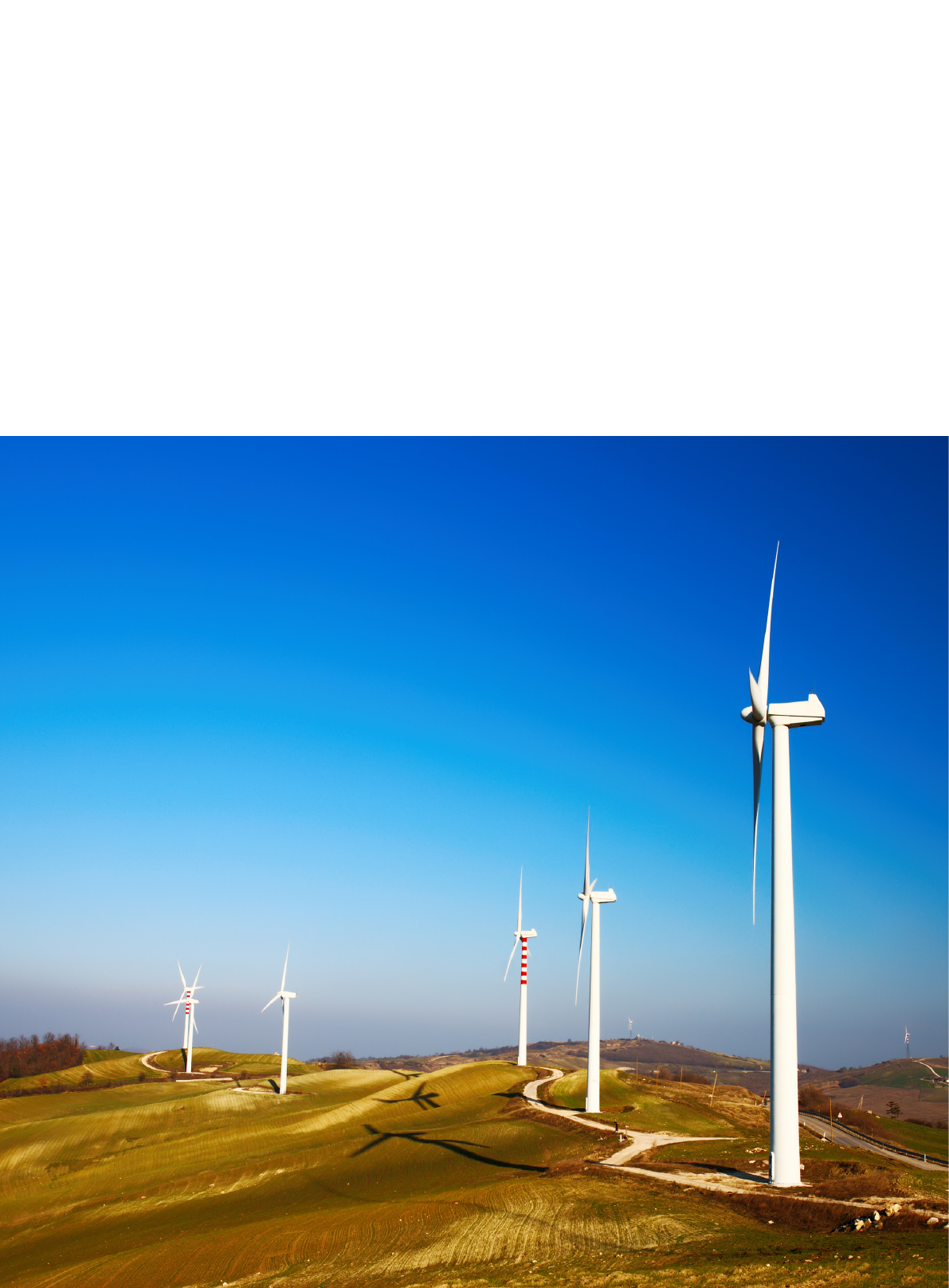
China 2050 High Renewable Energy Penetration Scenario
and Roadmap Study

HIGH RENEWABLE ENERGY
PENETRATION SCENARIO:
VISION AND CONSENSUS
HIGH RENEWABLE ENERGY
PENETRATION SCENARIO:
PATHWAY
HIGH RENEWABLE ENERGY
PENETRATION SCENARIO:
ACTION PLAN
CONTENTS
01 06 28

China 2050 High Renewable Energy Penetration Scenario
and Roadmap Study
HIGH RENEWABLE ENERGY
PENETRATION SCENARIO:
VISION AND CONSENSUS
Do not ever think about that we can escape, our every each
step determine the nal outcome, our foot steps are moving
towards the end of own chosen target.
— Milan Kundera
CHAPTER 1

01
China 2050 High Renewable Energy Penetration Scenario
and Roadmap Study
Strengthen Environmental Constraints
1
CONSENSUS ON DEVELOPMENT
We are continuously writing new chapters
in our history. In the history of energy, it is
an irreversible path that we will gradually
move away from dependence on fossil fuels
and transit to a “high renewable energy
penetration” future. The "China 2050 High
Renewable Energy Penetration Scenario and
Roadmap Study" analyzes how China can
gradually phase out fossil energy, especially
coal, from its leading role in China's energy
development, and give low-carbon green
electricity a prime part to play.
Given the severe landscape of tightening resource constraints, serious environmental
pollution, and degraded ecological systems, it is necessary to establish a strategic turning
point in energy development through the imposition of environmental constraints. China
needs to project an ecological civilization concept of respecting, complying with and
protecting the nature. China must also put ecological civilization development high on its
agenda, and integrate it into all aspects and processes of economic, political, cultural,
and social development. The goal is to build a beautiful China and realize sustainable
development. To achieve this grand objective, China needs to significantly cut back
on pollution emissions and restore to levels of the 1970s and 1980s. Based on the
environmental constraints, a backcasting mechanism is formed to reduce coal and oil
consumption. The study also sets restrictions on greenhouse gas (GHG) emissions - as 3.5
billion tons for the whole energy sector and 1.5 billion tons for the power sector in 2050.

02
China 2050 High Renewable Energy Penetration Scenario
and Roadmap Study
Submit to energy
authority the research
ndings and policy
recommendations
Information disclosure
and report release to
the public
Industry forecasts
reports and other paid
information services
Publications
Figure 1 Model Cluster
On the basis of broadly seeking expert advice, as well as learning and summarizing the contents and
methodologies of advanced international researches, this study establishes a decision-making framework
concerning the development goal of high renewable energy penetration in China. The decision-making process is
carried out by integrating techno-economic appraisal, energy system optimization, socio-economic assessment,
and externality analysis.
Optimize Development Paths
This study is based on scenario modeling aimed at the development and integration of high levels of renewable
energy. It sets up China’s 2050 electricity consumption demands, energy resource constraints, GHG emission
constraints, atmospheric pollution and other environment capacity constraints, techno-economic features of
electricity technology and other scenario information. This study adopts a host of assumed conditions, including
the upgrading of power technologies, the operational constraints of power systems, energy and resource prices,
and power demand. By employing a power system optimization model as the research tool and taking 2010 as the
baseline year, this study analyzes the optimal operation of power system and system expansion plan that meets
various constraints under the reference and high penetration scenarios in 2050. It analyzes the energy substitution
as well as environmental, economic, and social benets, and calculated the direct and indirect cost of developing
renewable energy. Based on such information, this study optimizes the development paths for the power
system between 2015 and 2050 under different scenarios, from the perspectives of geographical distribution,
distribution of time and the operation of the power system. The output of this study also includes the corresponding
Development plan of
renewable energy, allocation
of renewable energy
development targets
Impacts on national macro
economic sectors and
economic indicators (GDP,
CPI, etc.)
Policy effect, social
economic impact, policy
efciency and cost
Economic indicators
of renewable energy
technology, roadmap for
equipment manufacturing
industry and technology
R&D, industry development
forecast
MODEL
SYSTEM
MODEL SYSTEM PLATFORM
FOR DECISION-MAKING
MODEL
OUTPUT
INFORMATION OUTPUT
PLATFORM
Regional
optimized
deployment
model system
Macroeconomic
impact
assessment
model system
policy
evaluation
model
system
Technical and
economic
evaluation
system

03
China 2050 High Renewable Energy Penetration Scenario
and Roadmap Study
China needs to press ahead with signicant reforms in energy production and consumption patterns to
fully realize its goal of a clean, low-carbon, secure and reliable energy system by 2050. China must take
into account the lock-in effect of traditional energy systems, plan the future energy system in advance
and establish new energy production and consumption model. This will require China to constantly and
signicantly reduce the proportion of fossil energy, increase the proportion of renewable energy in energy
consumption, and develop scientic geographical distribution, industrial structure, as well as production
and living patterns that well supports energy efciency and renewable energy development.
Fossil energy for end-use and energy conversion processes will be signicantly reduced, totaling no more
than 1 billion tons by 2050. Renewable energy will be vigorously developed, accounting for over 60% of
the energy consumption and over 85% of the electricity consumption.
Adopt Target-Oriented Approach
implementation schemes for different development paths and the outlook of power system technologies
and operation management.

04
China 2050 High Renewable Energy Penetration Scenario
and Roadmap Study
The development target of a "beautiful China" is a strategic target with abundant meanings,
and the key is to realize harmony between man and nature, between people, and between
man and society. For that matter, we need to rst build a beautiful homeland featuring intensive
and efcient production, comfortable living, healthy ecosystem, clear water and blue skies. The
action plan to achieve a beautiful China is mainly manifested in the following three aspects:
Ecological Environment - Bring Back Clear Water and Blue Skies for
"Beautiful China"
Figure 2 2010-2050 GDP Growth Rate
2010 2020 2030 2040 2050
China's per capita gross national product (GNP) will reach the level of medium-developed
countries by the middle of the century. At that time, China will realize modernization, restore a
clean environment, and become a prosperous, democratic and civilized socialist country. This
is a scientic consensus reached in the whole Chinese society.
By 2050, China's population will be 1.38 billion and GDP will reach RMB282 trillion (constant
2010 RMB), which is 7 times of China’s GDP in 2010. By then, per capita GDP will reach
US$30,000 (constant 2005 US dollar, US$50,000-60,000 per capita) and China's GDP will
account for one-third of the world's total. By comparison, in 2011, OECD had a population of
1.241 billion and its GDP accounted for 73% of the world's total, while China had a population
of 1.341 billion and its GDP only accounted for 10% of the world's total. By 2050, China will be
the largest economy in the world.
Social Economy - Reach the Level of Medium-Developed Countries
LONG-TERM VISION
2
Trillion, constant 2010 RMB GDP average annual growth rate (%)

05
China 2050 High Renewable Energy Penetration Scenario
and Roadmap Study
If we take the socio-economic development level of OECD countries in 2010 as the reference for China’s
2050 socio-economic development, and base on that to set up China's future energy development path,
a reference scenario for primary energy supply will be formulated that includes a shift from today’s coal-
centered energy structure to a structure in which coal, oil&gas, and non-fossil energy each takes up one
third in 2050. In this case, 7 billion tce (tons of coal equivalent) of primary energy supply will be required
(fossil energy converted to primary energy based on conversion efciency; non-fossil energy converted
based on caloric value.
Under the high renewable energy penetration scenario, by 2050, China's end-use energy demand is
projected to be 3.2 billion tce, in which over 60% is electricity, and primary energy supply will be 3.4 billion
tce. The 2050 energy system in China will be highly efcient.
Higher electrification rate enables renewable energy utilization to grow to a higher level. In the high
penetration scenario, electricity will account for over 50% of China’s total end-use energy consumption;
total electricity consumption will increase to 13.5-15 trillion kWh and per capita 10,000-11,000 kWh. Putting
electricity at the central position of realizing high renewable energy penetration is objectively determined by
electricity characteristics, resource endowment and energy development law.
Electricity drives digital information technology and communication technology, and plays an important role
in supporting sustainable economic development. Electricity has become an important cornerstone of the
information age. Electric energy has covered virtually all regions of the world through transmission networks
and storage devices. Electricity usage marks the advancement of the human civilization, and the usage
rate of electric energy is also a scale that measures the socio-economic development level of a country.
Electricity will surely become an important driving force of the energy consumption revolution in transport,
building and industrial sectors as China realizes the development of high renewable energy penetration.
Therefore, to realize high renewable energy penetration, we need to prioritize electricity development, and
speed up transformation of the power system to emphasize resource sustainability, energy diversication,
system exibility, and consumer-oriented development.
Energy Development – Embrace A Low-carbon and Green Electricity Future
First, the level of intensive and economical utilization of resources is signicantly increased. Going forward,
China will need to further advance resource use efficiency, promote the transformation of resource
utilization patterns, enhance full-process conservation management, vigorously develop circular economy
and significantly reduce the consumption of energy, water and land. By 2050, energy, water and land
consumption per unit GDP will be down by 60-70% compared to today;
Second, pollutant emissions are reduced in an comprehensive manner and the environment is substantially
improved. The environmental carrying capacity for pollutant emissions is different in different periods and
countries due to the impact of geography, climate, diffusion conditions and other factors, but undoubtedly,
the emission of various kinds of air pollutants in China should be at least 50% lower than the current level,
reaching the level of developed countries or that of China in the early-1980s;
Third, natural ecosystems are comprehensively restored, and there is harmonious coexistence between
human, nature, and creatures. China will try to construct a scientific urbanization pattern, agricultural
development pattern and ecological security pattern and implement several actions, such as the protection
and construction of ecological function zones, the construction of national parks, integrated treatment of
water and soil loss as well as land desertication, and the protection of bio-diversity.

06
China 2050 High Renewable Energy Penetration Scenario
and Roadmap Study
HIGH RENEWABLE
ENERGY PENETRATION
SCENARIO: PATHWAY
CHAPTER 2

07
China 2050 High Renewable Energy Penetration Scenario
and Roadmap Study
China is home to a variety of renewable energy resources with rich reserves.
Under the high renewable energy penetration scenario, China's end-use energy
consumption in 2050 will be 3.2 billion tce and electricity will account for 62%.
China’s electrication rate will be up by 36 percentage points from 2010. Among
end-use energy consumption, 900 million tce will be directly consumed fossil
energy; non-fossil energy will account for 66% and renewable energy 60%. With
regard to power supply, 91% of power generation will be from non-fossil energy
and 86% from renewable energy. The primary energy supply will be 3.4 billion
tce, of which, 62% will be from renewable energy. Energy consumption per unit of
GDP will be 0.12 tce/10,000 yuan and energy efciency will increase by 90% from
2010.
1
By 2050, Renewable Energy Will Meet
60% of the Primary Energy Demand
Figure 3 China's Primary Energy Consumption
Units: 100 million tce (caloric value calculation)
Solar and geothermal heating Solar power
Biomass liquid fuel Biomass power
Wind power Hydropower
Nuclear power Natural gas
Petroleum Coal
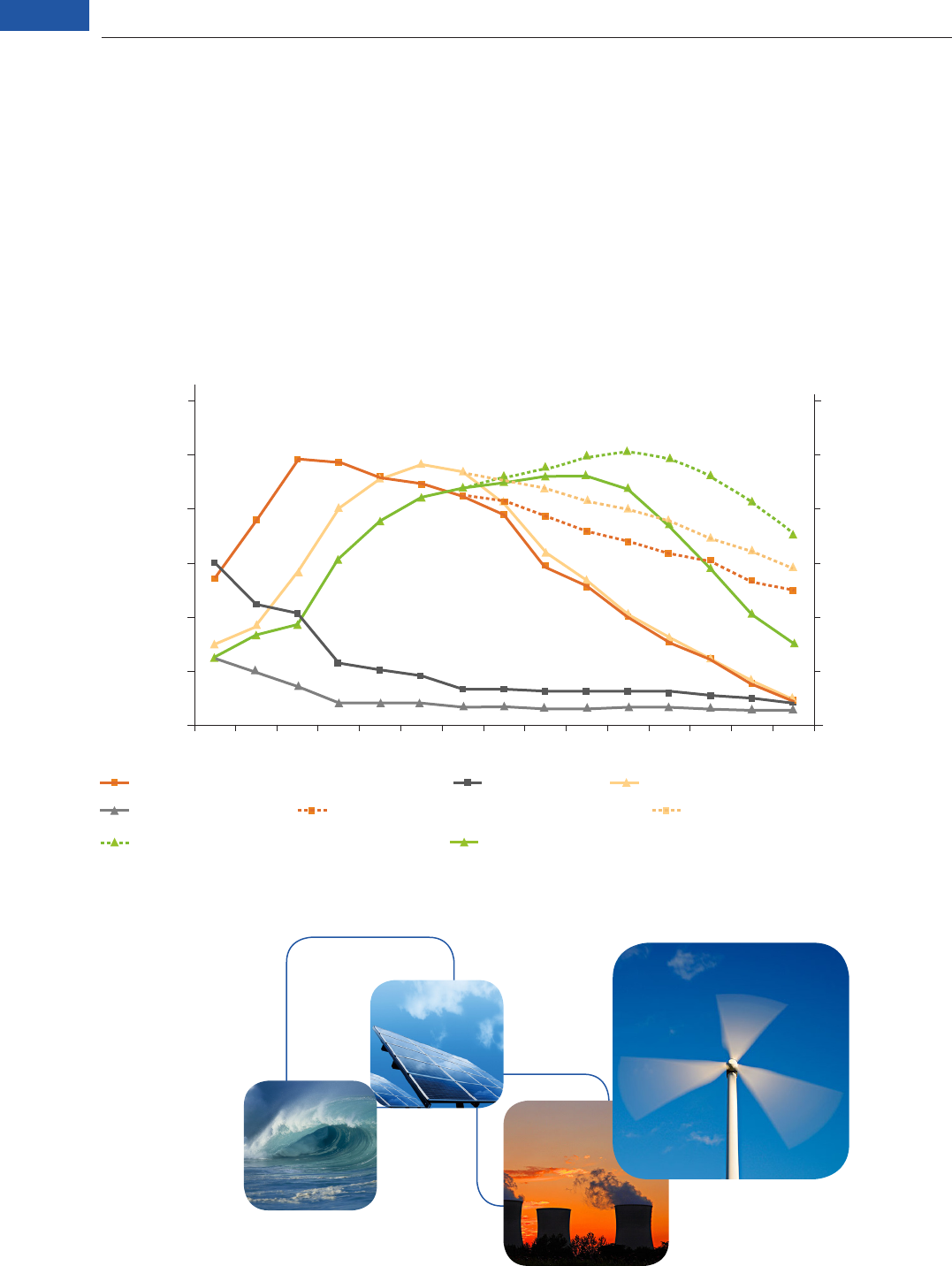
08
China 2050 High Renewable Energy Penetration Scenario
and Roadmap Study
The 2050 energy system will be dened by two features. First, the electricity-dominated energy supply system
will lead to a large increase of energy efciency and a sharp decline of the emission of various pollutants and
CO
2
. Second, with regard to power supply, 91% of power will be generated from non-fossil energy, and 86% from
renewable energy. When meeting the constraints of the economic development target, primary energy supply
under high renewable energy scenario will be 51% lower than under the reference scenario in which 2/3 of the
primary energy is fossil energy. As such, total primary energy supply will decline from 7 billion tce in reference
scenario to 3.4 billion tce, thus ensuring that the emission of various pollutants in 2050 will be no higher than that
recorded in 1980 and carbon emission intensity will be compatible with China's economic scale and population in
2050.
Figure 4 Emission of Major Air Pollutants in High Penetration Scenario
and Reference Scenario
Note: China’s data after 2012 is scenario analysis data and the US'
data after 2012 is trend prediction data Unit: 100 million tons
Unit: 10,000 tons
China SO
2
emission in high penetration scenario US SO
2
emission China NOx emission in high penetration scenario
US NOx emission China SO
2
emission in reference scenario China NOx emission in reference scenario
CO
2
emission in reference scenario CO
2
emission in high penetration scenario

09
China 2050 High Renewable Energy Penetration Scenario
and Roadmap Study
Under the high renewable energy penetration scenario, coal consumption peak will
be reached before 2020. Thereafter, fossil energy consumption peak will be realized
by 2025. The replacement of coal-red power generation by renewable energy power
generation will highly reduce coal consumption. Electricity, coking (iron and steel),
and manufacturing are the three largest coal-consuming industries in China. Under
the high penetration scenario, the proportion of renewable energy power generation
in the electricity mix will reach 86%, greatly reducing coal consumption, and will
promote power coal to peak at 1.45 billion tce in 2020 and then decline year by
year after that. By 2050, coal consumption in power sector will be only 280 million
tce. At the same time, by replacing traditional blast furnaces in iron&steel industry
with electric furnaces (which make steel using scrap iron & steel) and taking other
measures, coal consumption in coking industry will be reduced to 120 million tce in
2050. Therefore, coal consumption will peak at 2.65 billion tce before 2020 and drop
to 580 million tce in 2050, accounting for 17% of total primary energy. Although oil
and natural gas consumption will increase, fossil fuel consumption will reach the peak
value of about 3.7 billion tce between 2020 and 2025.
2
High Renewable Energy Penetration
Will Promote Fossil Energy
Consumption and Carbon Emission to
Peak by 2025
Figure 5 China's Coal Consumption by Sector in High Penetration
Scenario (million tce)
Manufacturing Chemical Coke Electric Power
Agricultural Transportation Residential Commercial Metal

10
China 2050 High Renewable Energy Penetration Scenario
and Roadmap Study
China has made the commitment to peak CO
2
emission before 2030. The high penetration scenario will further
drive carbon emission to peak earlier in 2025 and at lower value of 9.23 billion tons, and then decline constantly to
3 billion tons by 2050, taking up 20% of the world’s total compared to 1/3 in reference scenario.
Unit: 100 million tons
Figure 6 China's CO
2
Emission
Reference scenario High penetration scenario

11
China 2050 High Renewable Energy Penetration Scenario
and Roadmap Study
This study looks into the power sector development scenario under a fixed socio-
economic development goal. The high penetration power scenario could be a realistic
route of China's power development in the future.
The high renewable energy penetration scenario considers enhanced environment
constraints. The power system expansion route that meets resource, environmental and
ecological constraints will be selected through technical and economic optimization.
It assumes that economic development mode, power source structure, energy
saving and emission reduction technology, as well as the way of living will see major
improvements. By mainly relying on domestic energy resources, the high penetration
scenario could be realized with the great efforts.
The high renewable energy penetration power scenario enables China to solely rely on
its domestic energy resources and maximize renewable energy utilization. China will
increase investment in the renewable energy industry and grow it into a new economic
growth point and green employment opportunity. China will become a world leader in
renewable energy technologies, such as offshore wind power, low-speed wind power,
distributed solar power and concentrating solar power (CSP).
Based on commercialized power generation technology, the share of power generated
from non-fossil fuel will be signicantly increased. By 2050, the proportion of renewable
energy power generation will rise from 46% under reference scenario to over 85%
under the high renewable energy penetration scenario. The amount of power generated
from non-fossil energy will account for 91% of China's total power generation, and the
share of coal-red power generation will drop from 75% in base year to less than 7%
under the high penetration scenario, while meeting the hourly power demands across
China. China’s total installed power capacity will reach 7.1 billion kW, including 880
million kW of coal-red power, 220 million kW of natural gas power, 100 million kW of
nuclear power, 550 million kW of hydropower, 2.4 billion kW of wind power, 2.7 billion
kW of solar power, 210 million kW of biomass power, 140 million kW of pumped hydro
storage power and 160 million kW of chemical energy storage. Wind power and solar
power will become China’s backbone energy technologies under the high renewable
energy penetration scenario.
3
Renewable Power is the Essential
Replacement for Fossil Energy
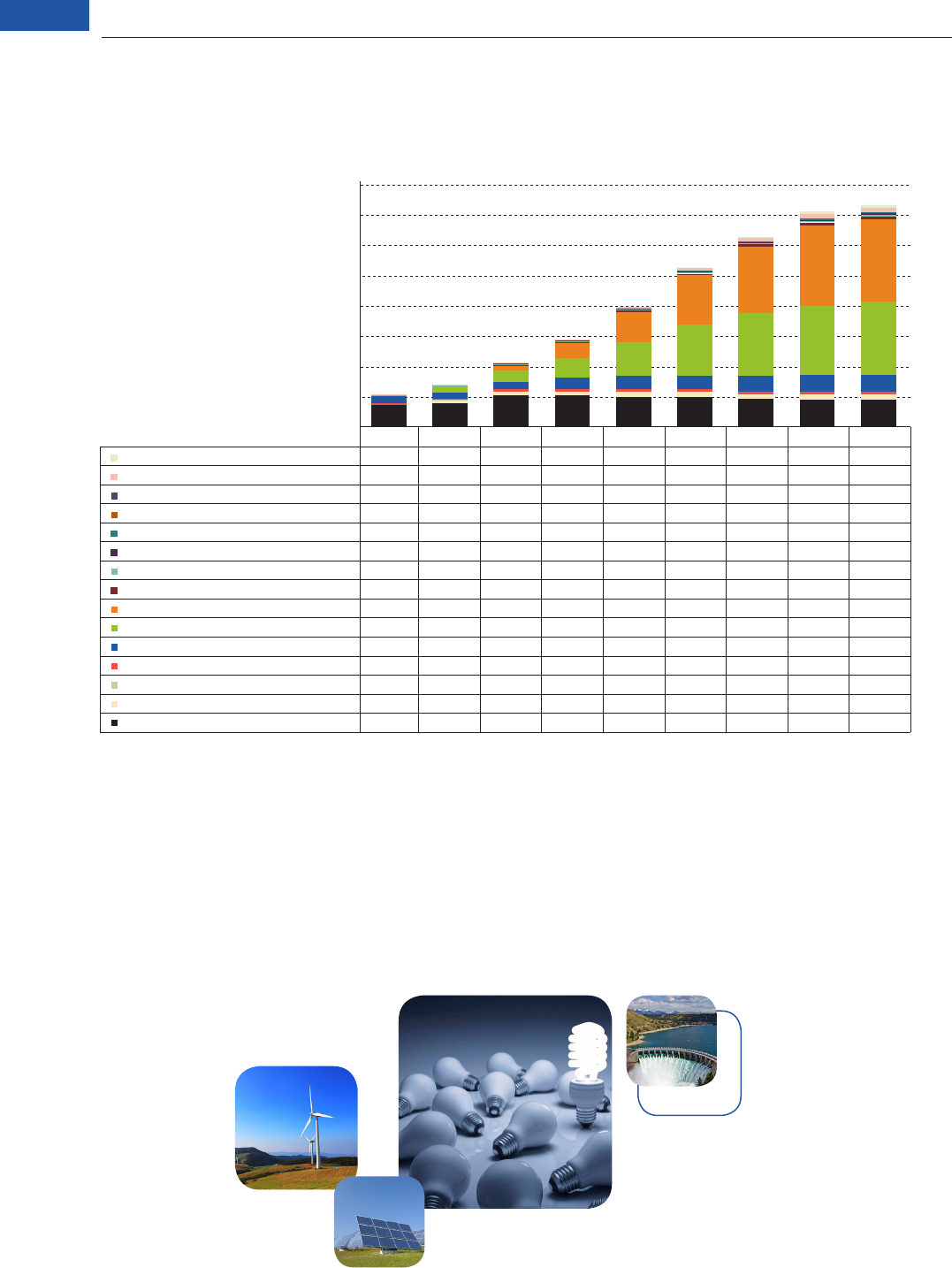
12
China 2050 High Renewable Energy Penetration Scenario
and Roadmap Study
China's total power generation will be 15.2 trillion kWh in 2050 under the high renewable energy penetration
scenario, including 1038 billion kWh of coal power, 466 billion kWh of natural gas power, 649 billion kWh of nuclear
power, 2187 billion kWh of hydropower, 5350 billion kWh of wind power, 4130 billion kWh of solar power and 1100
billion kWh of biomass power. Renewable energy will account for 85.8% of total power generation and non-fossil
energy 91%.
Installed Capacity (MW)
Figure 7 Power Installed Capacity in High Penetration Scenario
Chemical energy storage
Pumped hydro storage
Ocean energy
Geothermal power
Wood pellets power
Straw and stalk power
Biogas power
Municipal waste power
Solar power
Wind power
Hydropower
Nuclear power
Oil power
Natural gas power
Coal power

13
China 2050 High Renewable Energy Penetration Scenario
and Roadmap Study
Under the high renewable energy penetration scenario, the renewable energy deployment model (EDO)
optimizes the deployment of commercialized technologies under different levels of renewable energy
development, and fully demonstrates the diversity of geographical distribution and time distribution in
which renewable energy is generated. The contribution of onshore wind power is the most prominent,
while offshore wind power is playing an increasingly important role in realizing high renewable energy
penetration. Among solar power technologies, open field photovoltaic (PV) power station plays a more
prominent role than distributed solar. Under the high renewable energy penetration scenario, CSP
installations grow rapidly, largely because CSP with heat storage can offer greater adjustability. Biomass
power generation also has a place in the renewable energy mix, as there will be a shift from forest and
agricultural biomass power stations to municipal waste power plants along with the increase in the
proportion of renewable energy power and the demand for raw materials of biomass liquid fuel. Given
resource and techno-economic constraints, geothermal energy and ocean energy contribute less than
other renewable energy, especially under the high renewable energy penetration scenario.
Biogas
Fuel Oil
Natural gas
Hydropower
Nuclear power
Solar energy
Straw and stalk
coal
Municipal solid waste
Wind power
Geothermal energy
Wave energy
Wood pellets
Pumped hydro storage
Chemical energy storage
Fig.9 2050 Renewable Energy Installed Capacity by Region in High Penetration Scenario
Ocean energy
Geothermal power
Biomass pellets power
Straw and stalks power
Biogas power
Municipal Solid Waste power
Solar power
Wind power
Hydropower
Nuclear power
Oil power
Natural gas power
Coal power
Figure 8 Power Generation under High Penetration Scenario
POWER GENERATION (TWH)
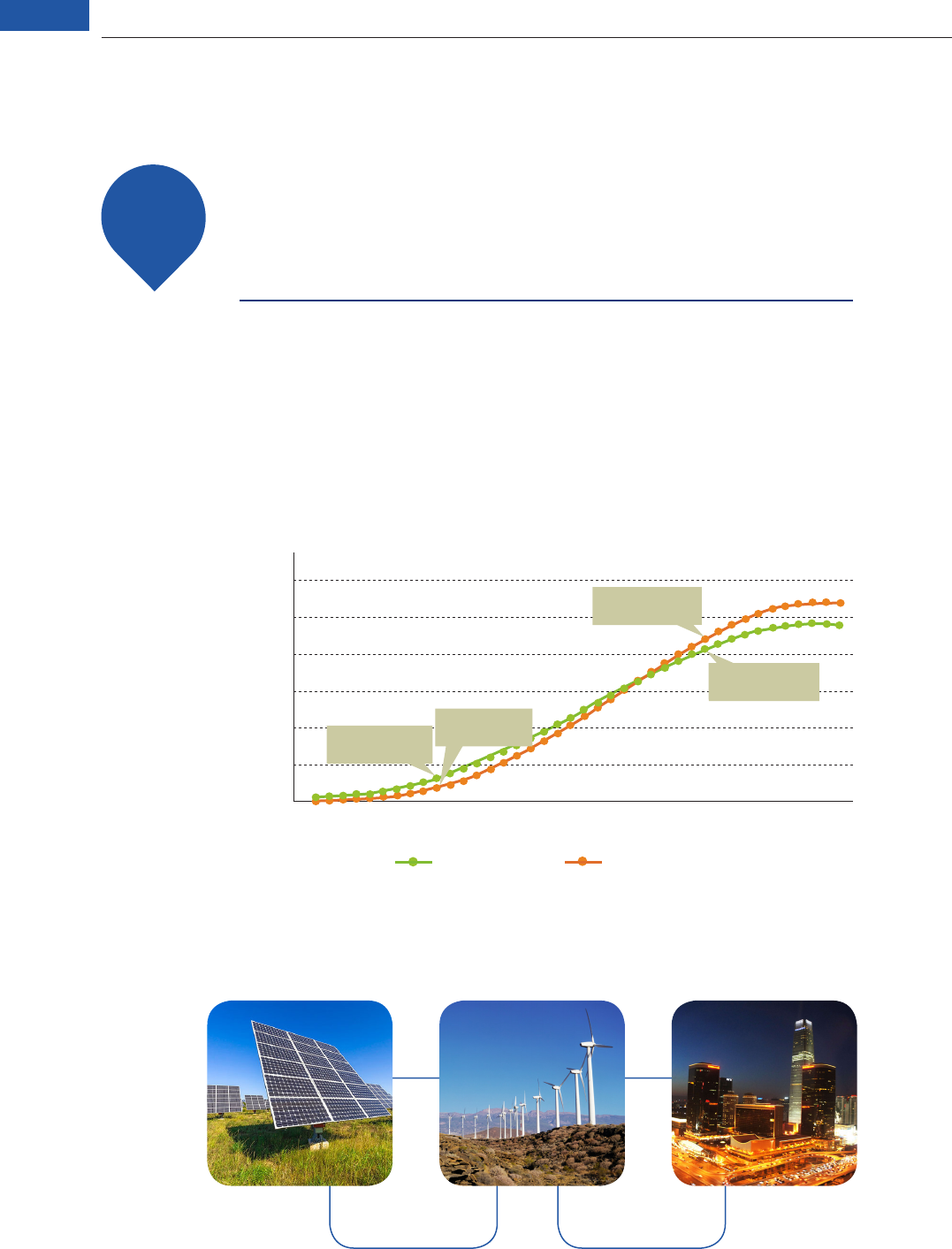
14
China 2050 High Renewable Energy Penetration Scenario
and Roadmap Study
By 2050, 2.4 billion kW of wind power and 2.7 billion kW of solar power will be installed
with a total annual output of 9.66 trillion kWh, which accounts for 64% of China’s total
power generation. Wind and Solar will therefore become the main power sources
provided by the future green electric system. Thanks to technological breakthroughs,
cost reductions and comprehensively deepening power sector reforms, wind power and
solar power generation will realize dramatic development between 2020 and 2040, and
an average of close to 100 million kW of installed capacity will be added every year.
4
Wind Power and Solar Power Will Become Important Pillars of the Future
Power Supply
Figure 10 Development Phase Diagram of Wind and Solar Power
under High Penetration Scenario
Wind power
Solar power
2.056 billion kW
by 2040
2.204 billion kW
by 2040
307 million kW
by 2020
174 million kW
by 2020
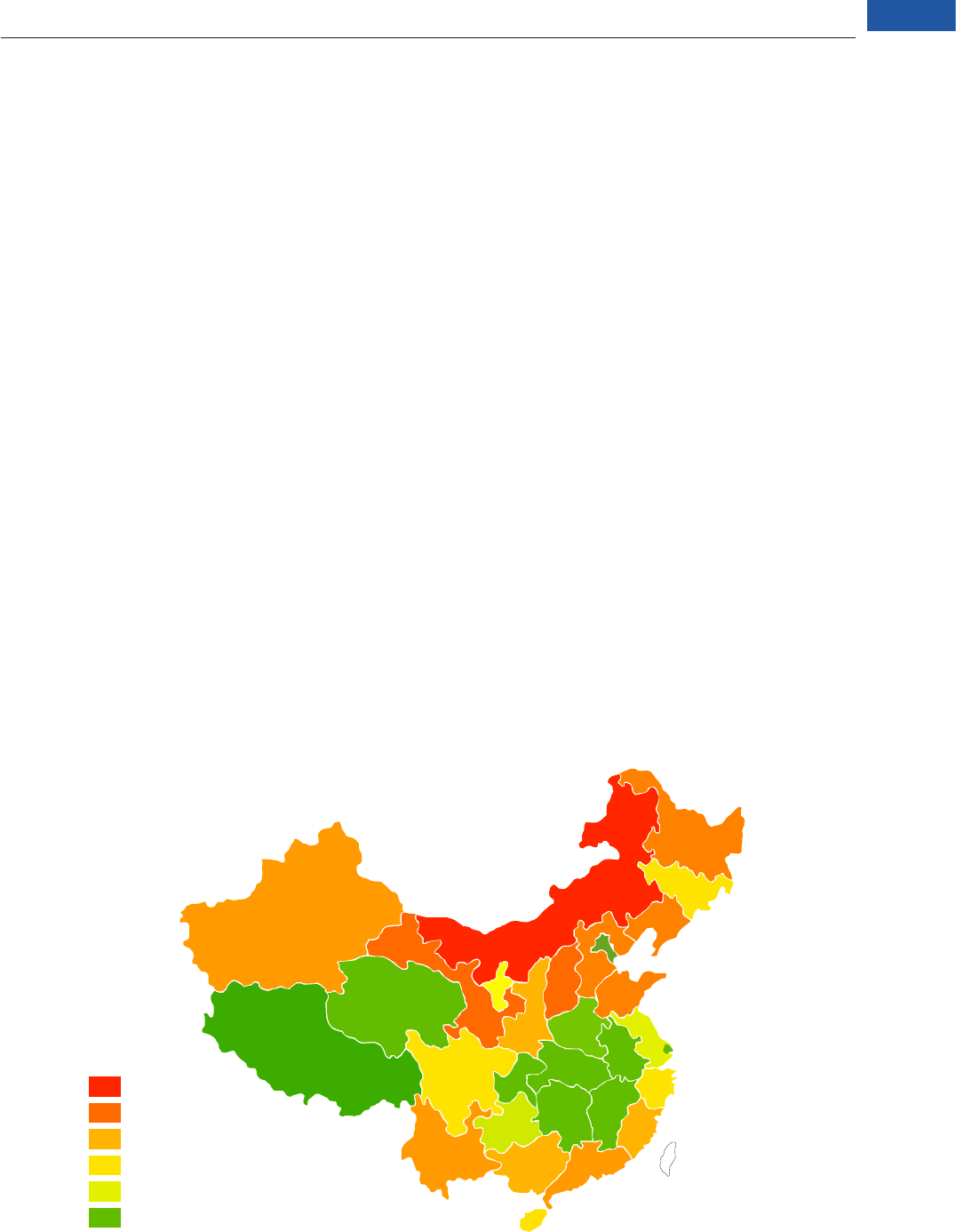
15
China 2050 High Renewable Energy Penetration Scenario
and Roadmap Study
Various areas of the country have the ability to develop wind power and solar power on a large scale.
Before 2020, given basic power grid conditions and possible transmission constraints, the main goal
is to develop a large-scale wind power market and industrial system that satises advanced technical
standards and codes, with onshore wind power at the core and intertidal and nearshore wind power
to supplement. The newly installed capacity of wind power will reach 25-30 million kW each year.
By 2020, the total installed capacity of wind power will reach 250 million kW. By that time, the cost
of wind power will become competitive with that of coal power, excluding the cross-provincial power
transmission cost; wind power will account for 11% of China’s total installed capacity and provide 5%
of power supply.
Under a high renewable energy penetration scenario, the economic advantages of wind power
will become visible before 2030. The market size of wind power will expand with the simultaneous
development of onshore and offshore wind. Newly installed wind capacity will be around 80 million kW
each year, accounting for roughly 50% of China’s total annual installed power capacity. As for onshore
wind facilities, the focus is to build large wind power stations in North China, Northeast China and
Northwest China, which will account for over 70% of total installed wind power capacity. Distributed
wind power in Central China and East China will develop more rapidly during this period. Offshore
wind power resources provide an additional option for coastal provinces like Hebei, Shandong,
Jiangsu, and Zhejiang. By 2050, the installed capacity of offshore wind power will amount to 300
million kW. By 2030, the accumulated installed capacity of wind power will surpass 1.1 billion kW,
becoming an important contributor for meeting power demand, improving energy mix and supporting
national socio-economic development. By 2050, the total installed capacity of wind power will amount
to 2.4 billion kW.
Figure 11 Layout of Wind Power Development in 2050
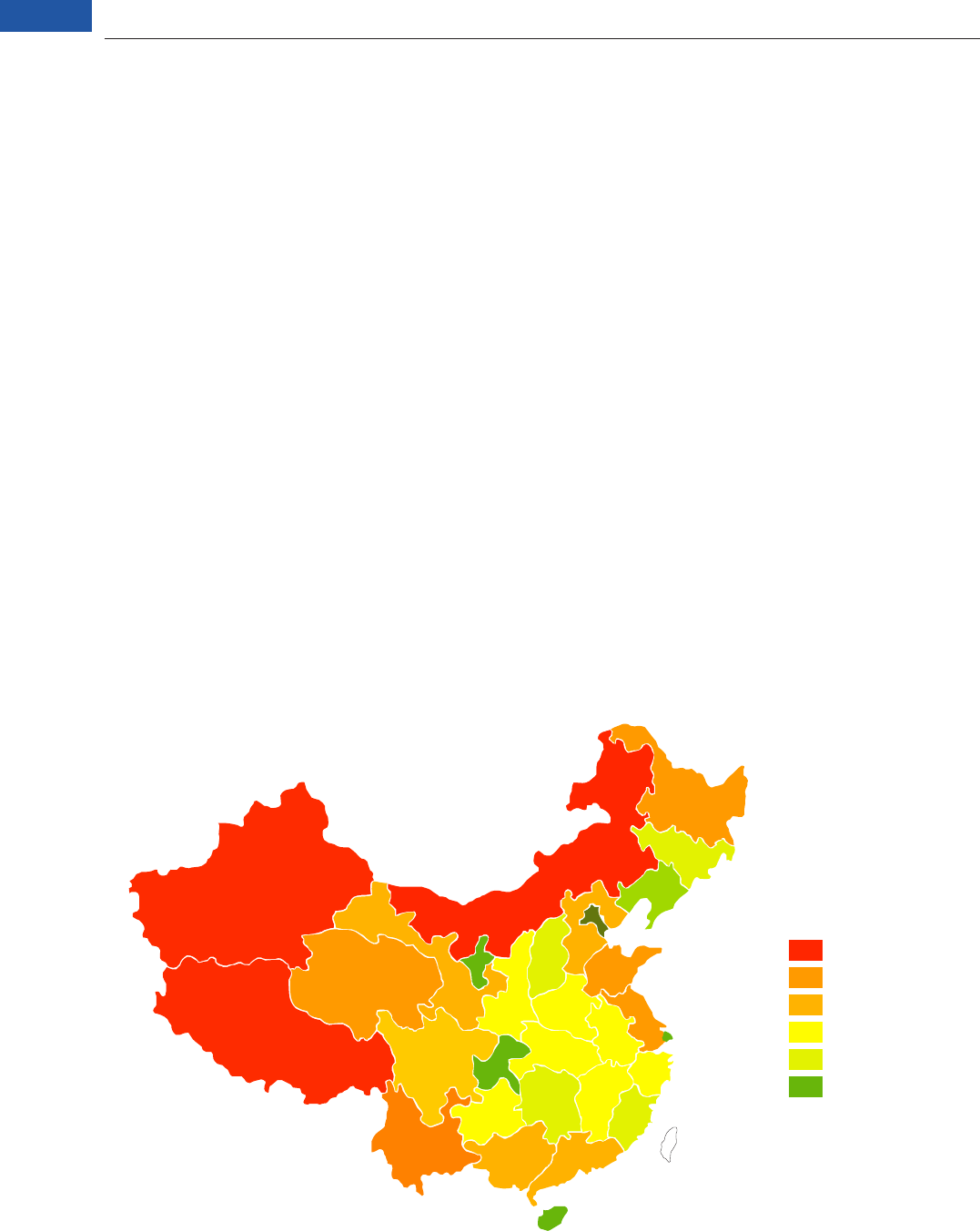
16
China 2050 High Renewable Energy Penetration Scenario
and Roadmap Study
Solar energy is China’s most abundant renewable energy resource, particularly in western China. Before 2020, the
average annual growth rate of the PV market will be around 35%, while by 2020, the installed capacity of PV power
will be around 130 million kW. The average annual growth rate will be maintained at 25-30% between 2020 and
2030, and by 2030, the installed capacity of solar power under the high penetration scenario will reach 1.05 billion
kW. Through large-scale development of CSP, China will have developed mature solar parabolic trough and solar
power tower industrial chains. The cost of CSP will be on a constant decline, and by 2030, the installed capacity of
CSP will be 50-100 million kW.
The economics of solar power generation will become more pronounced between 2030 and 2050 and its proportion
in the power mix will increase rapidly. Under the high penetration scenario, the installed capacity of solar power
will amount to 2.7 billion kW in 2050, including 1.9 billion kW of open-eld PV power stations and 350 million kW of
CSP. Distributed PV power will have big potential too, reaching about 260 million kW.
Based on the distribution of population without access to electricity, solar resources, electricity load, power grid
conditions, building roof areas (large industrial parks, commercial clusters and public buildings), and desert/gobi
land areas, solar PV power market can be classied into the following types: (1) electricity development and off-grid
micro grid projects for providing electricity to areas without electrication, primarily concentrated in China's western
provinces and offshore islands; (2) distributed PV power stations mainly concentrated in economically developed
provinces in mid-eastern China; (3) large PV power stations, mainly concentrated in 6 provinces in Western China
(Tibet, Xinjiang, Inner Mongolia, Gansu, Qinghai and Ningxia) and coastal provinces in Eastern China (Shandong,
Jiangsu, Zhejiang, Fujian, Guangdong, Guangxi and Hainan Island). CSP will mainly concentrate in Tibet and ve
Northwestern provinces.
Figure 12 Layout of Solar Power Development in 2050

17
China 2050 High Renewable Energy Penetration Scenario
and Roadmap Study
5
Higher Electrification Rate will Enable
Renewable Energy to Grow to a Higher
Level
The power system is the core of the future energy system in China. By 2050, electric power will account for
over 60% of end-use energy consumption and will become the primary source of energy for people’s production
and living. China will vigorously promote the utilization of electricity and renewable energy in industry, building,
transportation sectors, as well as power and thermal energy production sectors. China will also popularize clean
power, solar energy, biomass energy (fuel gas), geothermal energy and other modern renewable energy heat
utilization technologies in a comprehensive way, and increase the proportion of electricity in end-use energy
consumption.
Under the high penetration scenario, the share of electricity and renewable energy in end-use energy
consumption will further increase. By 2050, the total end-use energy consumption will be 3.157 billion tce.
Electricity will become the major end-use energy source, meeting 62% of end-use energy demand and
accounting for 61% of primary energy supply. 77% of all primary renewable energy will be used in power
generation.
Industrial sector: The goals here are to accelerate industrial technology upgrade and large-scale utilization
of renewable energy technologies; significantly reduce energy consumption in various industrial processes
through electried and mechanized production; replace fossil energy with electricity and renewable energy, and
strictly control the total consumption of fossil energy. By 2050, the energy efciency of various parts of China's
industrial sector will be up to the energy efficiency levels of developed countries. Under this scenario, the
industrial sector will play an important role in the improvement of energy mix.
Building: Building sector will largely utilize solar energy, biomass, and geothermal energy for heating, and
the proportion of fossil energy will decline year by year. Heating will be provided for buildings through district
heating, community boilers, heat pumps, and renewable power. Under the high penetration scenario, the era of
coal heating will end, and low-carbon and even zero emission buildings will become common.
Transportation: Under the high penetration scenario, China’s production and sales of new energy vehicles in
2020, including pure electric vehicles, plug-in vehicles, and fuel cell vehicles, will reach 2 million, and electric
vehicle stock will amount to 5 million. New energy vehicles, represented by electric vehicles, will be popularized
rapidly and the sales volume will surpass that of engine-fuel vehicles before 2035, becoming the mainstream
vehicle power technology. By 2050, the ownership of pure electric vehicle, plug-in hybrid electric vehicle and
hydrogen cell vehicle will account for 86% of the vehicle market.
Social civilization: Electricity is a kind of energy with the highest use efciency yet without any emissions among
all end-use energy varieties. The electrication level of a country, that is, the level of electricity use in production,
living and mobility, represents the degree of civilization of that country. By 2050, more than 80% of kitchen work
of Chinese residents will be completed mainly via electricity. The future era is an information era with a high-
degree integration of communication, energy, and logistics over the Internet, and that calls for the support of
high electrication rate.
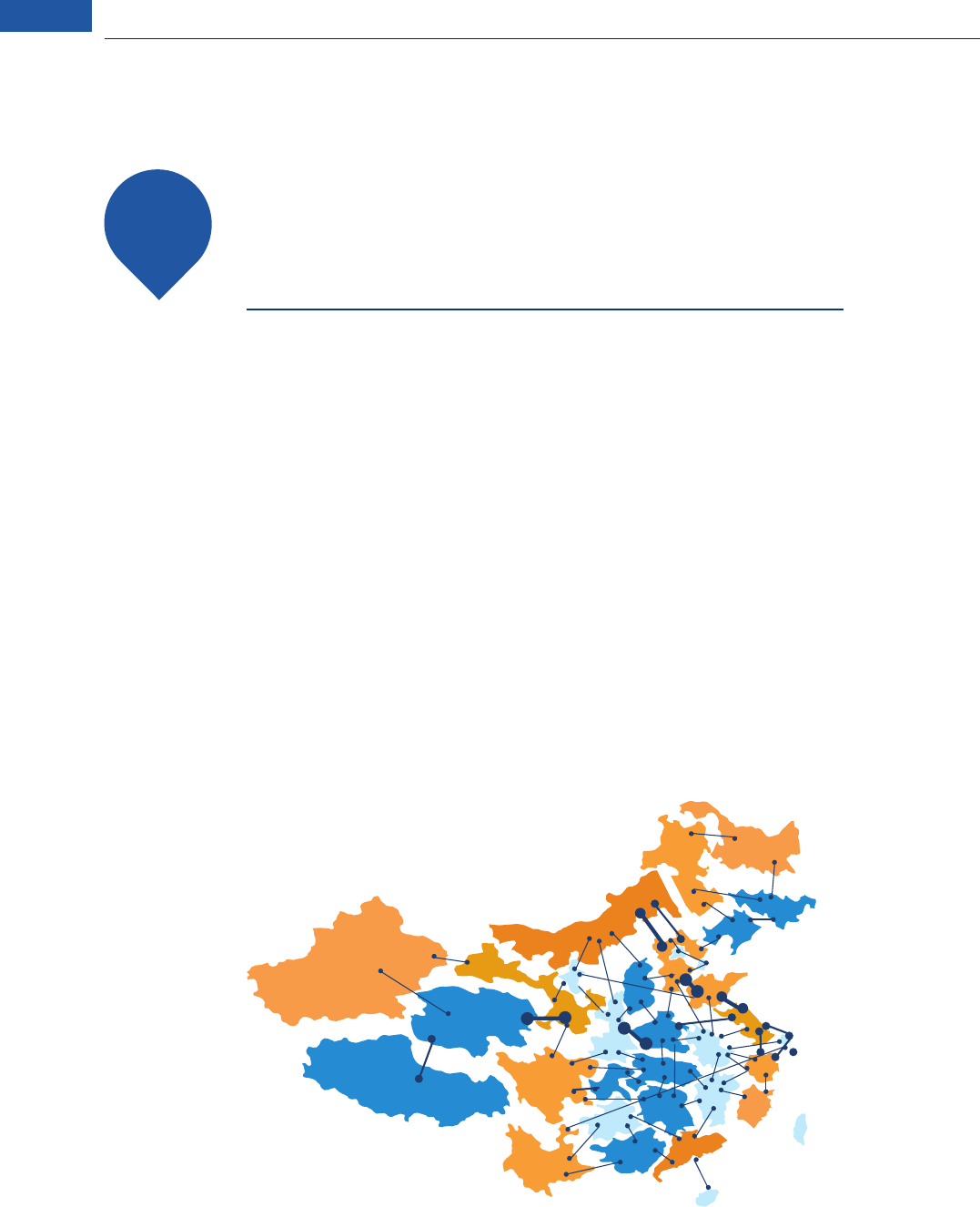
18
China 2050 High Renewable Energy Penetration Scenario
and Roadmap Study
With the increase of renewable power generation, new transmission will be needed
to transmit power from western and northern China to load centers in eastern
China, and to share electricity reserves and smooth out variability of renewable
power output over a wider geographic area. Increased transmission infrastructure
will help realize power transmission and electricity sharing within a larger area,
increase system exibility and balance changes in wind power and solar power
output and power load. As variable power generation is developed and utilized
on a large scale, the net load (load minus variable power generation) of some
specic regions will demonstrate drastic changes. Regional interconnection and
the geographic expansion of balancing areas will be helpful to reduce the changes
in net load because a wider balance area allows the system to schedule and
utilize large amount of renewable energy resources and more diversied power
technologies, and make the output and load in wider region smoother. Under the
high renewable energy penetration scenario, there will be three cross-regional
transmission lines with a capacity of more than 100 million kW - the Northwest-
Central China line, Central China-East China line and North China-East China
line. New transmission capacity required under high renewable energy penetration
scenario is higher than that of reference scenario, and transmission demand will
grow as renewable energy power increases.
6
Transform the Electricity
Transmission Network to a Platform
for Optimizing Resources Allocation
Figure 13 Inter-provincial Transmission Capacity Demand and the Total Installed
Capacity of Each Province (GW) under High Penetration Scenario

19
China 2050 High Renewable Energy Penetration Scenario
and Roadmap Study
Additional long-distance electric power transmission capacity is an important feature of the high
renewable energy penetration scenario in the future. Power production simulation and power flow
analysis demonstrates that east-west transmission have dual direction to exibly respond to temporary
changes in power supply and demand. The expansion of power transmission line makes eastern
load better connect with high quality renewable energy resources in western China. For now, major
challenges still yet to be tackled, including difficulty in siting and land acquisition for building new
transmission lines, transmission cost allocation, and coordination among regulatory authorities, which
have restricted the expansion of power transmission line on a large scale.
This study finds that new transmission under the high renewable energy penetration scenario will
concentrate in China's middle and western regions and will be mainly used to connect the high quality
wind power and solar power resources in the central and western regions and transmit that renewable
energy power to load centers in eastern China.
Figure 14 Cross-regional Transmission Capacity Demand under High Penetration Scenario

20
China 2050 High Renewable Energy Penetration Scenario
and Roadmap Study
Under the high renewable energy penetration scenario, planning and operation of the power
system will be subject to many challenges, including managing low demand and curtailing
excess power generation, among others. Analysis shows that contrary to the existing fossil
fuel-centered power system, where challenges mainly focus on peak load (such as a summer
afternoon), the operational challenge under the high renewable energy penetration scenario is
the most daunting during periods of low demand (such as a spring evening), because during
such times, renewable energy power generation exceeds demands, forcing thermal generators
to reduce output to the minimum power generation level. During periods of low demand with
the current system under the reference scenario, most down regulation demands could be met
by adjusting coal power and hydropower generator output. Although gas turbines need to be
operated, the demand is lower than that under the high penetration scenario. However, during
periods of low demand under the high renewable energy penetration scenario, high renewable
power output will lead to severe variability of the net load (load minus wind power and solar
power). The increase in net load variability will bring about challenges related to improving
peak regulating capacity and system exibility.
Under the high renewable energy penetration scenario, wind, solar and hydropower
curtailment will be reduced through a series of technical and institutional measures. First,
China will upgrade the capacity of the transmission system to alleviate congestion, and reduce
curtailment; second, China will emphasize energy storage technologies and help reduce the
capacity of online power generators that provide spinning reserve; decrease the number of
power plants that run at the minimum level, and reduce the curtailment of renewable energy
power generation; third, China will increase the exibility of thermal generators, and encourage
flexible generators to operate more often; fourth, China will increase energy storage and
controllable load, and enhance system flexibility; and, China will implement power trading
through power market; and nally, in spring or during periods of low demand, industries may
increase consumption of lower-cost electricity so as to increase demand, and the electricity that
would have been curtailed can be consumed instead.
Modeling of the power sector shows that in order to adapt to the increase in renewable power
generation, China needs to deploy a more exible system. System exibility could be enhanced
based on multiple options on the supply and demand side. However, China needs to improve
technology, formulate new operational procedures and develop new business models and new
market rules. As renewable power generation will increase from 46% in the reference scenario
to 85% in the high penetration scenario in 2050, the contribution rate of variable power will
rise from 30% to 60%, making it more challenging to maintain the real-time balance between
electricity supply and demand. Variability and uncertainty associated with high penetrations of
wind power and solar power will be managed by adding exible power capacity, improving the
exibility of coal power plants, using energy storage devices (including pure electric vehicles)
and demand response mechanisms, and expanding transmission infrastructure.
7
Technological and Institutional Innovation is
the Foundation to Build a High Renewable
Energy Penetration Power System

21
China 2050 High Renewable Energy Penetration Scenario
and Roadmap Study
By 2050, 85% of China’s total power generation will be provided by renewable power, and 60% by variable
renewable power such as solar and wind. With the above-mentioned measures, China can balance the hourly
power supply and demand in each region. Figure 15 shows the contribution of each type of generation across
China on a typical day under the high renewable energy penetration scenario.
Figure 15 Analysis of the Hourly Dispatch of Nationwide Power Generation on a Typical Day in
High Penetration Scenario
Nuclear power
Coal power
Hydropower
Gas power
Wind power
Wood pellets power
Solar power
Geothermal energy
Biogas power
Straw and stalk power
Municipal solid waste power
Ocean energy
Oil power
Pumped hydro storage

22
China 2050 High Renewable Energy Penetration Scenario
and Roadmap Study
This study quantifies and evaluates the average per-kWh cost under different
scenarios, including power transmission cost, unit start-up cost, fuel cost, fixed
cost O&M, variable cost O&M and capacity cost. The gure below demonstrates
the development trend of average per-kWh cost and levelized kWh cost by
technology under the high penetration scenario.
Advancements in renewable energy technologies, such as improvements in
technology cost and performance have the greatest impact on reducing the
incremental cost in high renewable energy penetration scenario. The average
cost of the high renewable energy penetration scenario is pretty close to that of
the reference scenario. Under the high renewable energy penetration scenario,
the average cost per kWh of electricity will rise slightly between 2030 and 2050,
basically remaining between RMB0.672/kWh and RMB0.685/kWh, while in
reference scenario the average cost between 2030-2050 will stay flat around
RMB0.67/kWh.
8
Building a High Renewable Energy
Penetration Power System at a Small
or Non-Incremental Cost
Transmission cost
Unit start-up cost
Fuel cost
Variable cost O&M
Fixed cost O&M
Capacity cost
Figure 16 Trend of kWh Cost Development in High Penetration Scenario
RMB/kWh
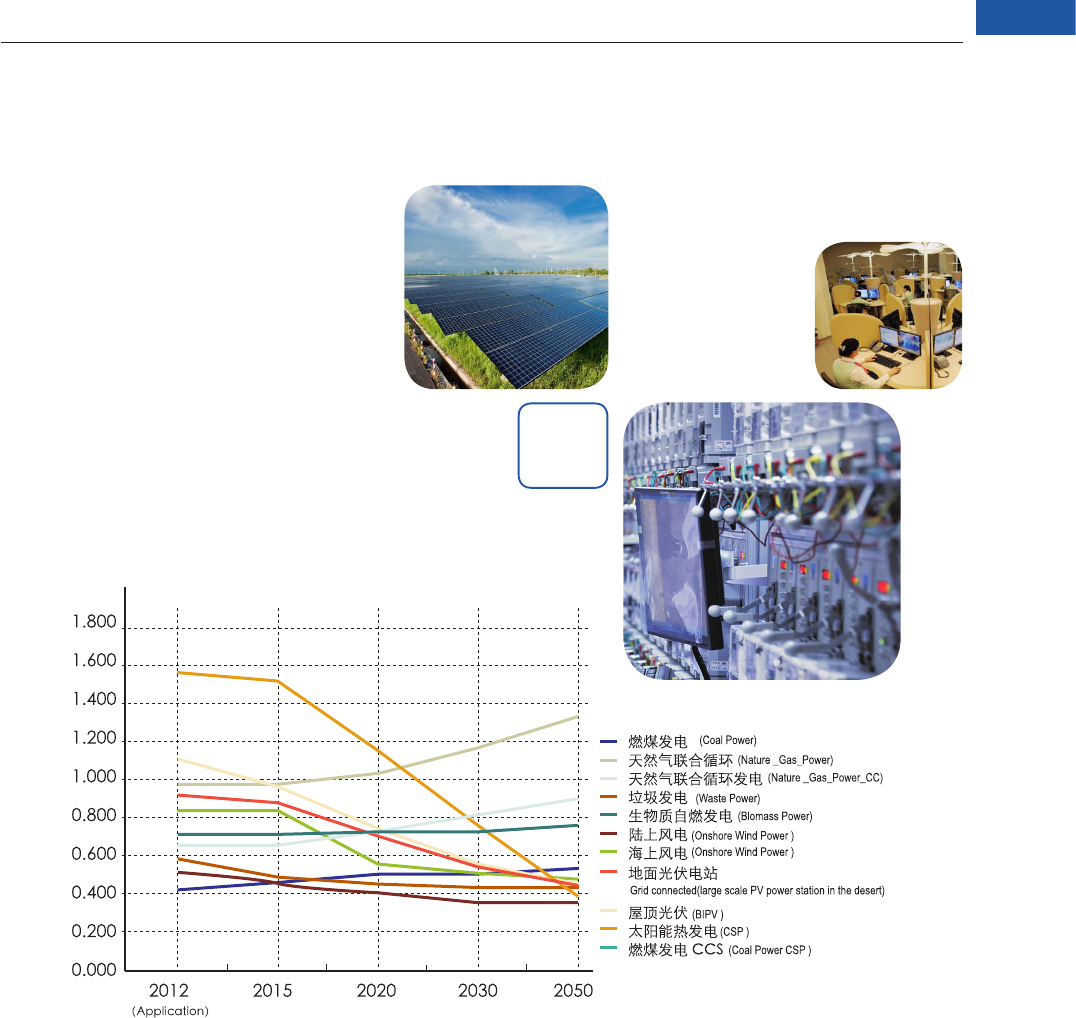
23
China 2050 High Renewable Energy Penetration Scenario
and Roadmap Study
Similar to other high penetration studies, the analysis of the per-kWh cost under the high renewable
energy penetration scenario shows that fuel costs drop drastically while capacity costs and power
transmission costs increase. Major factors contributing to a decrease first and then an increase in
relevant costs under the high renewable energy penetration scenario are as follows: capacity cost -
existing power plants replace new power equipment (mainly renewable power generation equipment);
and the additional cost for gas turbines, energy storage equipment and the construction of power
transmission lines. Compared with the reference scenario, most of the incremental capital investment
related to these factors will be offset by the reduced fuel costs from fossil energy plants not generating
as much as in the reference scenario. Therefore, through constant evolution and improvement of
renewable technology, renewable power generation will increase dramatically in comparison with the
reference scenario under the premise of a small or non-incremental cost. Furthermore, the analysis of
incremental costs doesn't take into consideration the social costs (such as the environmental impact
caused by GHG emission and air pollutants) or economic impacts.
Figure 17 Levelized kWh Cost Development in High Penetration Scenario

24
China 2050 High Renewable Energy Penetration Scenario
and Roadmap Study
Under the high renewable energy penetration scenario, wind power, solar energy, electric vehicles
and other emerging industries will become a new economic growth point. China's projected
aggregate economic performance will increase from RMB40 trillion in 2010 to RMB280 trillion – a
7-fold increase. In 2050, the contribution of total added value of related renewable energy industries
to GDP in 2050 is estimated to increase from a mere 0.9% in 2010 to 6.2% in 2050. The added
value of wind power industry will reach RMB3.8 trillion in 2050, 108% higher than RMB1.8 trillion
in the reference scenario. The added value of solar power industry will amount to RMB2.8 trillion,
nearly 5 times higher than RMB0.5 trillion in the reference scenario. In addition, renewable energy
industry’s technical and industrial demands for equipment manufacturing, electronic instruments, and
weather forecast, etc., will stimulate the manufacturing of machinery, electronic products, research &
development (R&D) and service industries. The total added value of the renewable energy industry
supply chain will grow to RMB17 trillion, and electric vehicle production will record nearly RMB8
trillion, accounting for 6.2% and 2.9% respectively of GDP and together, contributing more than 9% of
GDP.
9
As a New Economic Growth Point, Renewable
Energy Can Signicantly Improve the
Development Quality of the Overall Economy
In the meantime, the development of more renewable energy plants will create 12 million jobs (in
2050) in the renewable energy industry and related industries. Among others, the number of jobs in
solar power generation and heat utilization, PV equipment and other solar-related industries is the
highest at 4.8 million, while wind power and related industries reaches 3.8 million. Electronics, R&D,
electricity and other supporting industries required by renewable energy development are mainly
emerging industries, and high renewable energy penetration scenario will promote the transmission
of China’s employed population from traditional manufacturing to high value add industries. Research
demonstrates that the number of workers in traditional fossil energy industries such as coal mining
and washing industry, oil rening industry, and transportation is declining year by year and by 2050;
the number of workers in electricity, service, electronic machinery and research industries will
increase by 2.61 million, 1.62 million, 1.41 million and 0.96 million, respectively. In the next 40 years,
China will minimize the impact on employment of traditional energy sectors by the development of
new employment opportunities in renewable energy industries, and the retirement and transfer of
staff in some traditional energy industries to other industries after receiving job training and career
guidance.
Figure 18 Contributions of Renewable Energy and Related Industries to GDP
Wind power industry chain
Solar energy industry chain
Electric vehicle
Total renewable energy industry chain
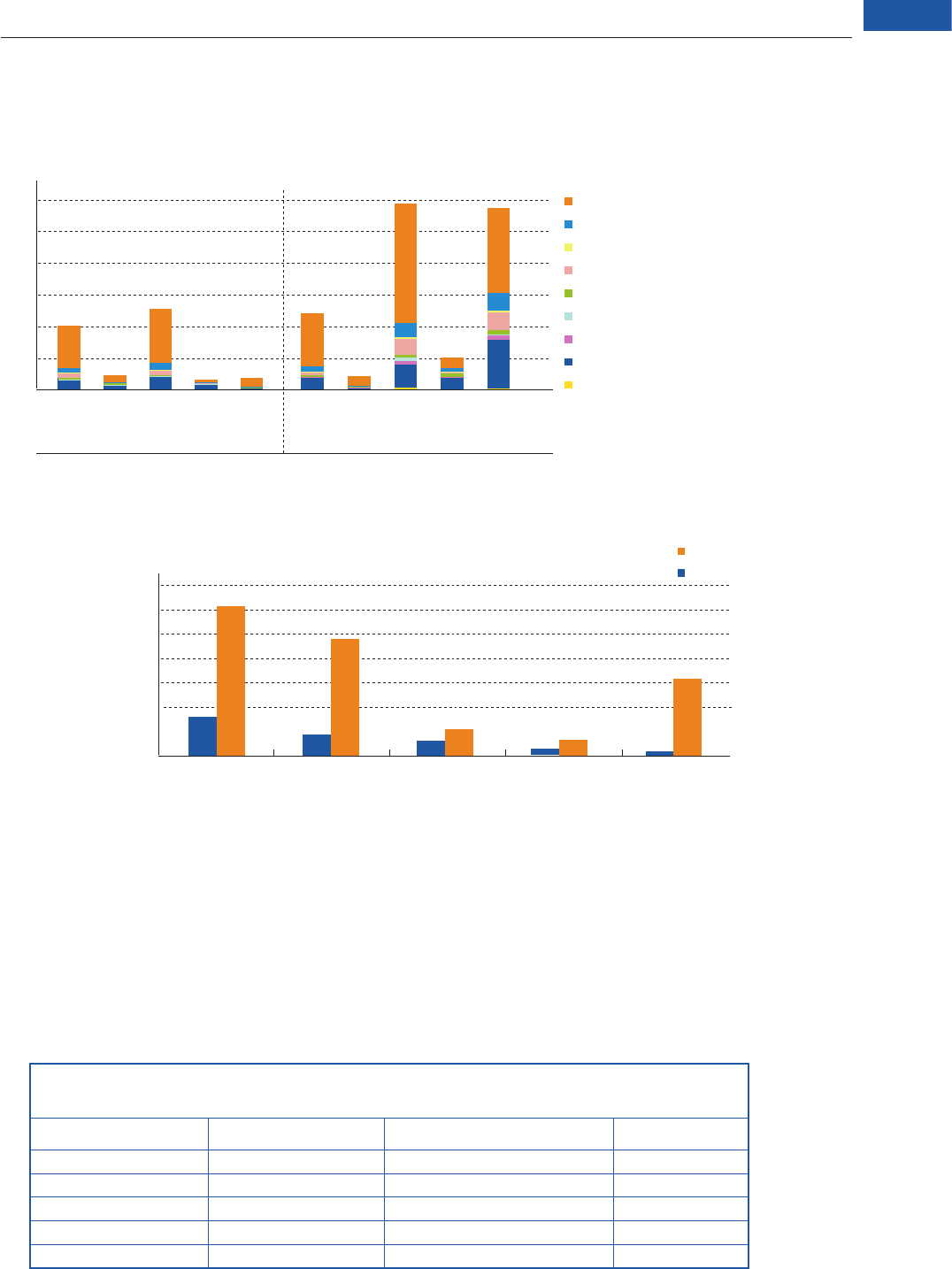
25
China 2050 High Renewable Energy Penetration Scenario
and Roadmap Study
In general, the development of high renewable energy penetration has elevated the quality of macroeconomic
development in China. Our study results show that compared with the reference scenario, the development of
high levels of renewable energy does not negatively impact the economic performance. Instead, renewable
energy development actively promotes the adjustment of economic structures and enhancement in the quality of
economic growth. For instance, under the high renewable energy penetration scenario, residents' consumption
contributes more to GDP, while government spending is relatively smaller, which is beneficial for residents
to share the results of economic growth in a more fair and effective way. In addition, the aggregate level of
international trade is enhanced, the domestic price level is effectively controlled and the quality of economic
growth is further optimized.
141.2
33.2
70.5
69.6
0.909
141.5
32.8
71.1
70.2
0.908
+0.23%
-1.44%
+0.87%
+0.88%
-0.11%
Table 1 Impacts of High Penetration Scenario on Marco Economic Indicators
(2050, trillion Yuan)
Figure 20 Growth of Employment in Renewable Energy and
Related Industries (Unit: 10 Thousand)
Figure 19 Added Value of Relevant Industries Driven by Renewable Energy in
High Penetration Scenario (10 billion yuan)
Added value (10 billion yuan)
Residents' consumption
Government spending
Export
Import
Price level
Reference scenario High penetration scenario Change
Solar energy Wind power Hydropower Biomass Others
Direct added value
Service industry
R&D industry
Transportation
Building
Other manufacturing industries
Electronic products manufacturing industry
Machinery manufacturing industry
Metal products industry
Hydropower HydropowerNuclear
power
Nuclear
power
Wind
power
Wind
power
Biomass
power
Biomass
power
Solar
power
Solar
power
Reference scenario High penetration scenario

26
China 2050 High Renewable Energy Penetration Scenario
and Roadmap Study
High renewable energy penetration is expected to replace coal consumption
significantly, and by 2050, China's total coal consumption will be less than 600
million tce, only about 1/3 of that as consumed in 2010. Major pollutants and CO2
emitted by the combustion of fossil energy will decrease signicantly. According to
the modeling results, China's CO2 emission will drop from today's about 10 billion
tons to 3 billion tons in 2050, a 55% decline from 6.7 billion tons in 2010. In 2050,
projected per capita CO2 emissions will be 2.17 tons, a 51% decline from the
world average in 2010 (4.44 tons) and a 46% decline from the world average in
1990 (3.99 tons).
10
High Renewable Energy Penetration
Will Help Bring Back Clear Water and
Blue Skies
If the entire international community could work together to control the temperature
rise to less than 2 degrees Celsius, China's CO
2
emission in 2050 will be only
about 1/4 of the world's total. Compared with the share of China's GDP in the
world's total, China will make a great difference in improving the world’s ecological
environment. Europe and the United States have made the industrialization
journey with large-scale CO
2
emissions. Other studies predict that Europe and
Figure 21 China's CO
2
Emission in the Global Contrast in High
Penetration Scenario
China USA EU Proportion of China's
CO
2
in the world's total
Unit: 100 million tons Note: China's data after 2010 is scenario analysis data and the
data of other countries is trend prediction data from IEA ETP 2014

27
China 2050 High Renewable Energy Penetration Scenario
and Roadmap Study
Figure 23 China's SO
2
Emission in High Penetration Scenario
Figure 22 China's NOx Emission in High Penetration Scenario
the United States are witnessing the decline of emissions from peak in 2005 to the emission target in
2050. China will reduce its CO
2
emissions in a shorter period by developing high levels of renewable
energy that in turn will result in dramatic declines in China’s carbon emissions.
China has developed and implemented pollution emission control strategies since the 12th Five-year
Plan period. The quantity of SO
2
and NOx emissions of China peaked at 2005 and 2010, respectively,
and have since declined year by year. The high renewable energy penetration scenario will further
accelerate the reduction in total emissions of major air pollutants, and SO
2
and NOx emissions will
be at about 2.5 million tons and 2.7 million tons, respectively. The emission of major pollutants (SO
2
,
NOx, heavy metal Hg, etc.) will be kept even with 1980 levels. China will witness the restoration of
clean water and blue skies.
Unit: 10000 tons
SO
2
emission in high penetration scenario
Unit: 10000 tons
NO
X
emission in high penetration scenario
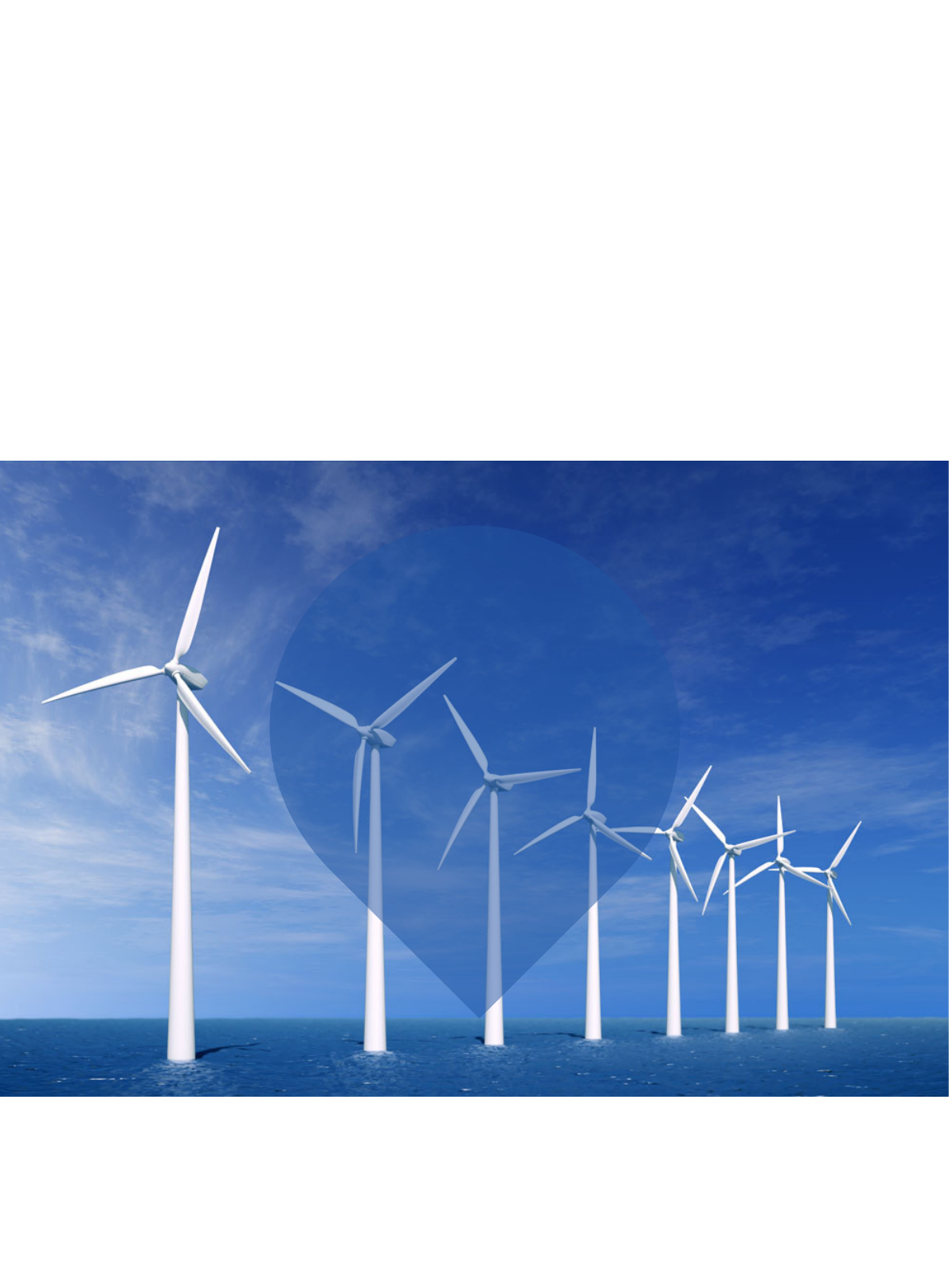
28
China 2050 High Renewable Energy Penetration Scenario
and Roadmap Study
HIGH RENEWABLE ENERGY
PENETRATION SCENARIO:
ACTION PLAN
CHAPTER 3

29
China 2050 High Renewable Energy Penetration Scenario
and Roadmap Study
In order to adapt to China's future energy transformation, China shall regard the realization of high
renewable energy penetration as an important part of the national energy strategy. This objective shall
be substantially demonstrated in all energy-related development plans to be rolled out. China needs
to formulate a high renewable energy penetration roadmap, break down the general objective into
specic objectives at different development stages; prioritize and dene tasks in the national energy
strategy; and identify necessary conditions, major obstacles, key elds and main jobs to realize high
renewable energy penetration at different development stages.
Specifically, government departments shall enhance guidance and promotion in terms of strategic
planning and policy management from now to future stages; renewable energy industries shall
vigorously pursue technological innovations and the development and utilization of renewable energy;
the electricity sector shall adapt to the features of new renewable energy technologies and construct
a public grid service platform and work on developing a more flexible power system; the building
industry, transportation and other end-use sectors shall advocate the replacement of fossil energy
by clean electric power and renewable energy, build urban clean energy systems, and develop a
smart energy Internet, thereby jointly establishing the future energy system and realizing the energy
revolution.

30
China 2050 High Renewable Energy Penetration Scenario
and Roadmap Study
Government departments will identify the long-term goals and roads for pollutants and CO
2
emissions reductions in the energy sector according to the requirements of the ecological civilization.
Government departments shall formulate the strategy of establishing and meeting goals for 2030and
2050, so as to ensure that renewable energy will account for 23% and 60% of primary energy
consumption respectively, and that CO
2
emissions from the energy sector will peak before 2025 and
decline sharply in 2050;
Establish and implement strategy and action plans for renewable energy priority development, and
develop renewables priority development roadmaps in forms of power generation, heat supply,
electric vehicles and biofuel throughout energy production and end-use sectors, so as to increase
the penetration level of renewables and enable it to replace new installations of fossil energy in 2020,
and phase out existing fossil energy capacity after 2030;
Implement a target and action plan for controlling total energy consumption, especially total fossil
fuel consumption, to ensure that coal consumption, the installed capacity of coal power and oil
consumption peaks before 2020, in 2020 and around 2025, respectively;
Develop and deliver strategies and roadmaps concerning major infrastructure construction, key
scientic and technological innovation and major public platforms so as to guide, support and serve
industrial development.
Government departments will accelerate the development of an electricity price setting mechanism
that is based on market competition as well as supply and demand, and use the advantage of
renewable energy with zero marginal cost to realize the preferential scheduling of renewable energy.
Preferential scheduling will occur after the transitional period of renewable power generation that is
preferentially arranged under the existing annual power generation plan;
Actively introduce multi-department controlled electricity price systems, establish a capacity market
and ancillary services market, incentivize the capacity and ancillary services of various market
participants, and promote different participants to offer exible market services;
Establish inter-provincial regional and national power trading markets, and break down the separation
of power markets among provinces and regions and among power grids;
Set up an independent trading (scheduling) platform, recover the misplaced public rights from utilities
(especially power grid companies), and develop and improve the public governance mechanism of
the independent power trading and scheduling platform;
Separate the power transmission and distribution networks, and launch regulatory oversight of power
transmission and distribution; and
IW1mprove demand side response, energy storage and other market management systems that
support exibility.
Formulate and Implement Clean Low-Carbon Energy Revolution Strategy and Action
Plan, Which Prioritize Renewable Energy
Establish Power Market Mechanism Adaptable to Handle Renewable Power
1
Major Actions of Government

31
China 2050 High Renewable Energy Penetration Scenario
and Roadmap Study
Government departments will move forward with transitioning to green taxes, accelerate reforms of
resource taxes and implement environmental taxes and carbon taxes so as to ensure that the price
of fossil fuel energy will cover resource depletion, the external costs of environmental pollution and to
create a level playing eld for renewable energy;
Establish and operate a total carbon emission control and trading system, promote the paid issuance
of emission permits on a larger scale, gradually tighten carbon emission constraints, and promote the
mark-up of fossil fuel use costs and the shift of major players under emission controls to renewable
energy utilization;
Increase support for funding of renewable energy and other clean and low-carbon energy by using
resource taxes, environmental taxes and the proceeds of auctions of carbon emission permits in the
short and medium term.
Government departments will ensure lawmaking goes rst, promulgate Energy Law, revise Electricity
Power Law and improve Renewable Energy Law, clarify the preferential development position and key
mechanisms of renewable energy at different levels, and enhance legal protections on the preferential
development of renewable energy and institutional transformation;
Strengthen comprehensive management functions and implementation effect, signicantly enhance
integrated and scientic planning to guide, regulate and coordinate China’s energy development, and
break geographic market barriers. All these will jointly promote comprehensive energy development
nationwide and safeguard priority development of renewable energy and new energy;
Move forward with the reform of an investment management system for renewable energy projects,
adapt to the features of renewable energy projects, including smaller-scale and diversied investment,
construction and operation, broaden access to project investment, promote and attract investment
develop more renewable energy project; and
Establish modern and specialized energy and electricity supervision systems. Additionally,
government departments will reform the traditional way of supervision, put in place a professional
supervising pattern that is formal, standardized and digital, that matches with comprehensive energy
management; and consolidate such reforms as laws, regulations, standards and supervisory systems.
Improve the Green Tax System and Carbon Trading Market System to Create A Fair
Playing Field for Renewable Energy
Establish Sound Systems of Legal Protection, Comprehensive Management and
Professional Regulation Adaptable to Renewable Energy Development

32
China 2050 High Renewable Energy Penetration Scenario
and Roadmap Study
Hydropower: improve the management, residents resettlement and ecological environmental protection
systems and mechanisms; constantly develop the 13 national level hydropower bases and various small
hydropower stations to ensure a steady increase of hydropower at certain level of growth rate, and
orderly develop new hydropower base in southeastern Tibet at proper time;
Wind power: move forward with the development of large wind power bases in the three North areas and
coastal areas in an orderly manner, accelerate the development of scattered wind energy resources in
inland areas; actively and properly promote offshore wind power development, and develop offshore wind
power in deeper waters far offshore in the long term;
Solar power: build large PV power stations in western China; promote distributed PV power generation in
urban and rural areas advance CSP industrialization’ and promote the diversied utilization of solar power
generation so that PV and CSP power will see large-scale utilization and become main power sources;
Biomass power: actively and efciently develop power generation from various biomass fuel sources, and
comprehensively promote the efcient and clean utilization of biomass resources;
Geothermal and ocean energy: establish experimental and demonstrative projects, and complete
commercially-oriented projects that are larger in scale than experimental and demonstrative projects. The
larger projects will play an important role in special regions and areas.
Solar heating: promote the utilization of low-temperature solar thermal energy in large urban and rural
areas and demonstrate the utilization of medium-high temperature solar thermal energy;
Biomass heating: promote the use of biogas, briquette fuel and various urban-rural wastes (industrial
organic wastewater, excrements of livestock, etc.), and utilize various biomass resources in a
comprehensive and efcient way;
Geothermal energy for heating: widely advance the direct utilization of shallow layer geothermal energy
and promote the large-scale application of ground source heat pumps; and
Electricity heating: conduct pilots and demonstrations based on regional heating supplies.
Build Major Public R&D Platforms, Strengthen Technology R&D, and Accelerate
Industrialization Process
Keep Sustained Large-scale Development of Renewable Power Generation
Fully Promote Renewable Energy Heating and Fuel Use
2
Major Actions of Renewable Energy Industry
The renewable energy industry will develop a resource database and atlas, and provide rened evaluation
results of wind power, solar power and other renewable energy resources;
Create a public technology platform, including public technology R&D and service platforms for wind
power, solar power, and the micro power grid;
Promote technological R&D, especially facilitating the R&D, demonstration, promotion and application
of core and key technologies, including efficient wind power, solar power generation, biomass power
generation, and integrated application of medium-high temperature solar heating.

33
China 2050 High Renewable Energy Penetration Scenario
and Roadmap Study
Power sector participants will build a cross-provincial and cross-regional main power
grid, an advanced power distribution network and smart grid in a scientic manner, and
develop a comprehensive service-driven power grid. Power sector participants will also
establish an electricity scheduling platform that has advanced technologies, integrates
work closely related to power forecasting, real-time scheduling operations and
concentrated monitoring of transformer devices, and realizes full-process optimization
and the multi-domain coordination of the scheduling of wind power and other new
energy sources. Another goal for the power sector is to boost the function of the power
grid to develop from a traditional power transmission and distribution network into a
comprehensive service-driven power grid platform with a mix of power transmission,
resource allocation, and interactive services; actively develop smart micro grids, and
build a smart power distribution network that adapts to high levels of distributed power
generation; and build a comprehensive service-driven power grid platform featured by
the integration of two-way power transmission and interactive services.
The power sector will optimize and run power generated from conventional energy
sources; control the size of coal power and gradually turn to backup and peaking power
sources; optimize and develop various exible power sources on a large scale; build
natural gas power generation;, fully tap into the regulating capacity of CSP, geothermal
power generation and nuclear power in the long term; coordinate the layout and
operation of hydropower projects, wind farms, PV power stations and other traditional
power sources and grids, and promote the complementary operation of wind/hydro
energy, wind/gas, and other diversied generating technologies.
Power sector participants will develop adjustable load and continuously expand the
scale of adjustable load to make it the most important exible resource; arrange and
construct a batch of pumped storage hydro power stations; make power grid operation
safer, more stable and economical; avoid accidents; vigorously develop new energy
storage measures, including advanced batteries, compressed air energy storage and
electric vehicles; and promote the development and use of advanced energy storage
technologies.
Build a New-Type of Grid Public Service Platform
Optimize the Deployment, Structure and Operation of Flexible Power
Develop Demand Response Mechanisms and Energy Storage in a Large Scale
3
Major Actions of Power Sector

34
China 2050 High Renewable Energy Penetration Scenario
and Roadmap Study
China will undertake a publicity campaign aimed at encouraging citizens to respect and
protect nature. The people shall also accept that developing renewable energy is the
only way to truly realize the sustainable utilization of natural resources and ecological
and environmental friendly energy development. The society shall also rmly seize on
the historical opportunity of the new round of energy revolution and the Third Industrial
Revolution. The country shall capture the development opportunity from integrated
distributed energy production and utilization, increased electrification rate in energy
end-use, and "Internet Plus". Everyone shall promote the production and utilization
of clean renewable energy through joint actions, starting with waste classification,
treatment and utilization, rooftop PV systems, electric vehicles and vehicle-network
integration. Citizens should also become energy prosumers, so that everybody
contributes to and benets from energy production and consumption. China will fully
enter into a new energy era with such major features as a green, low-carbon, clean,
efficient, and smart grid that successfully incorporates high penetration renewable
energy.
Some industrial sectors will be pushed to boost scientific and economic power
alternatives; promote the large-scale application of renewable energy heating utilization
technology in industries with lower requirements for the quality of heat energy, such
as printing and dyeing, and the textile and food industries; facilitate the utilization of
renewable energy heat in industrial sectors with higher requirements for the quality
of heat energy, including electricity, iron & steel, and chemical industries, so that it
will become an important energy source of heat supply in industrial sectors. Power
alternatives and the application of renewable energy heat utilization technology will be
fully realized to replace conventional fossil fuel energy on a large-scale.
China intends to popularize and install solar water heaters across the board; expand
renewable energy heating and refrigeration systems to make renewable energy a
major supplemental energy source for residents and businesses hot water, heat
supply and refrigeration; and promote building rooftop and building integrated PV
power generation. Renewable energy will become one of the major energy sources of
residents and businesses in terms of hot water, heat supply and refrigeration. Roof-
mounted PV system and new building integrated PV systems will be advocated on a
large scale.
Transform Energy Development Mindset Concept and Make Everybody a
Renewable Energy Prosumer
Promote Electrication and Renewable Energy Heating in Industry
Sectors
Promote Application of Renewable Energy Heating and Solar PV Power in
to Residential and Commercial Buildings
4
Joint Actions of the Society Broadly

35
China 2050 High Renewable Energy Penetration Scenario
and Roadmap Study
Electric vehicles will be popularized and extended on a fast track so that they will enjoy
application on a certain scale before 2020; the role of base load will be preliminary, and
millions of kw of base load and exible resources will be formed by 2030.
China will actively demonstrate and promote development of smart buildings, smart
residential communities, micro grids, and integrated energy networks; build an
advanced smart energy internet through integration of the energy system, Internet
of Things, and Internet; integrate various types of energy-consuming facilities of the
industry, building and transportation sectors with the power grid, gas pipelines as well
as local distributed energy such as solar energy, wind power and geothermal energy;
transform various kinds of renewable energy and fossil energy into multiple energy
forms such as cooling, heating and electricity according to demand of end users, and
put in place a smart energy internet featuring sustained production of clean energy and
intelligent allocation of energy resources.
Promote Electrication in Transportation Sector to Increase Valley Load
and Improve System Flexibility Through Energy Storage
Build Urban Renewable Energy System and Energy Internet

36
37
China 2050 High Renewable Energy Penetration Scenario
and Roadmap Study
China 2050 High Renewable Energy Penetration Scenario
and Roadmap Study
Major Actions of Government,
Renewable Energy Industry, Power
Sector, and the Society Broadly
Before 2017 2020 2030 2050
GOVERNMENT
RENEWABLE
ENERGY
INDUSTRY
POWER
SECTOR
IV. JOINT
ACTIONS OF
THE WHOLE
SOCIETY
(I) Formulate and Implement Clean Low-Carbon
Energy Revolution Strategy and Action Plan,
Which Prioritize Renewable Energy
(II) Establish Power Market Mechanism Adaptable
to Renewable Energy Development
(I) Build a New-Type Grid Public Service Platform
(I) Transform Energy Development Mindset and
Make Everybody a Renewable Energy Prosumer
(I) Build Major Public R&D Platforms and
Technology Innovation System
(III) Improve the Green Tax System and
Carbon Trading Market System to Create A
Fair Playing Field for Renewable Energy
(II) Optimize the Deployment, Structure, and
Operation of Flexible Power
(II) Promote Application of Renewable Energy
Heating and Solar PV Power in Residential and
Commercial Buildings
(IV) Promote Electrication in Transportation
Sector to Increase Valley Load and Flexible
Energy Storage
(II) Keep Sustained Large-scale Development of
Renewable Power Generation
(IV) Establish Sound Systems of Legal Protection,
Comprehensive Management and Professional
Regulation Adaptable to Development of
Renewable Energy
(III) Develop Demand Response Mechanisms and
Energy Storage in a Large Scale
(III) Promote Electrication and Renewable
Energy Heating in Industry Sector
(V) Build Urban Renewable Energy System and
Smart Energy Internet
(III) Fully Promote Renewable Energy Heating
and Fuel Use
Formulate energy revolution strategy and action plan for
2030 and develop vision and goals for 2050.
Deregulate power sales market; establish renewable
power priority dispatch mechanism; make power trading
centers independent from grid.
Develop demonstrations of smart grid and micro grid;
promote integrated utilization of wind power and solar PV
power forecast system; construct inter-regional power
transmission lines.
Design innovation-oriented technology roadmap; build
public platforms for resource assessment, technology
R&D and testing for renewable energy such as wind
power and solar power.
Levy resource tax and environmental tax; and use the
fund collected to support renewable energy development.
Control and optimize the layout of coal power development in
eastern area; speed up the construction of pumped hydro storage
and natural gas power stations; improve the regulating capacity of
coal power (including combined heat and power generation).
Build a batch of demonstration projects (or zones) of
offshore wind power and distributed solar PV power.
Revise Electricity Law, strengthen power system
planning, and expand investment access; modernize
regulatory system.
Develop demonstrations of adjustable load and demand
response; develop pumped hydro storage; demonstrate
advanced energy storage technology.
Enhance communications with the general public to let
them fully recognize that renewable energy is the only
road to a clean energy future
Speed up the development of building roof-top and building
integrated PV power; build demonstration projects (or
zones) of renewable energy hot water, heating and cooling
in residential and commercial buildings.
Develop demonstrations in printing and dyeing, textile,
and food industries of using electricity and renewable
energy heating to replace fossil energy
Promote electric vehicle development and encourage
charging during valley load period.
Develop demonstrations of micro grid and integrated
energy network in buildings, communities, or regions
to realize integrated utilization of renewable energy,
electricity, gas, and district heating.
Develop demonstrations of solar heating, biomass
heating, and geothermal heating technology and
innovative business models.
Make coal consumption and coal power installed
capacity peak by 2020; CO
2
emission peak between
2020 and 2025.
Establish competitive bidding market, multi-part tariff,
cross-provincial and cross-regional power trading
market; promote the separation of power transmission
and distribution networks.
Fully promote smart grid; build advanced power
dispatch platform, and realize large-scale, hierarchical
integrated and optimal dispatch.
Basically build up wind power and solar power
technology system; average levelized cost of wind
power and solar power reduce to less than RMB0.5/
kWh and RMB0.6 /kWh.
Build up carbon trading market; start to allocate
carbon emission permits through auction; and levy
carbon taxes.
Fully control the scale of coal power; expand the scale
of pumped hydro storage and natural gas power; tap
the regulating capacity of coal power, concentrating
solar power, and nuclear power.
Straighten out hydropower development mechanism
to realize steady development; accelerate the
development of both centralized and distributed wind
power and solar power.
Everyone should take actions to promote the
production and utilization of renewable energy.
Scale up renewable energy heating and cooling
system; fully promote roof-top PV system and building
integrated PV system.
Promote large-scale application of using electricity
to replace primary energy consumption and using
renewable energy for heating in printing and dyeing,
textile, and food industries.
Electric vehicles have reached a certain scale, and
contribute to increasing valley load.
Develop demonstrations of urban integrated clean
energy network that mixes the energy supply service
for residents, businesses, industries, and transportation
sectors, and experiment smart energy Internet.
Promulgate Energy Law, improve Renewable Energy
Law, and build a regulatory system in coordination
with the market-oriented reform.
Expand the scale of adjustable load; promote
application of advanced energy storage technology on
the user side.
Promote the utilization of medium-low temperature
renewable energy heat; promote the commercialized
demonstration of advanced biofuel technology.
Fossil energy consumption reach peak and
begin to decline; renewable energy replace
the stocks of fossil energy.
Set up a modern electric power market
system under the support of the smart grid.
Vigorously promote micro grid; build smart
distribution grid suitable for high penetration
of distributed generation.
Grasp advanced integrated application
technology of renewable energy; wind
power and solar power generation are fully
economically competitive.
Fully implement the allocation of carbon
emission permits through auction
Change coal power into standby and peaking
capacity; coal power and gas power become
major adjustable power sources; all kinds of
power supply have the ability of adjustment.
Fully develop hydropower and roof –top PV
power; accelerate the pace of wind power
and solar power development in North
China, Northwest, and Northeast.
Energy users become energy producers
and consumers (prosumer).
Fully promote renewable energy heating
and cooling system; new buildings are
mandated to install building integrated PV
system.
Promote the utilization of renewable energy heat
in such industrial sectors with higher requirement
for the quality of heat supply, including electricity,
iron & steel and chemical industries.
Fully promote electric vehicles and form a
valley load of about 100 million kW.
The energy network, Internet of Things
and the Internet couple to form an "energy
Internet".
Build sound systems of legal protection,
comprehensive management and
professional regulation.
Fully tap the potential of adjustable load;
popularize advanced energy storage
technology.
Promote the utilization of medium-high
temperature renewable energy heat in
industrial and commercial elds.
Renewable energy meet 60% of energy
demand and 80% of electricity demand;
CO
2
emission decrease sharply.
Form a 21
st
- century electricity market
that is open to everyone.
Establish a comprehensive service-
oriented grid platform integrating two-way
transmission and interactive services.
Build world leading renewable energy
technology and industrial system.
Complete formation of a green tax system
and a carbon market system.
Fully establish a diversied and exible
power system.
Fully realize the diversied utilization of
various types of renewable power generation
technologies; the proportion of renewable
power generation exceed 80%.
Realize a new situation that everyone
enjoys, every family sells and everybody
benets from energy.
Renewable energy dominate residential
and commercial heating and cooling.
Fully popularize the use of electricity and
renewable energy heating to replace fossil
energy on a large scale
Popularize electric vehicles and provide a
valley load of more than 1 billion kW.
Fully develop smart energy Internet.
Form new-type energy management
system
Demand response and energy storage
become important exible resources.
Fully popularize the utilization of low-
temperature solar heat and meet the
heat demand of all buildings and some
industrial users.
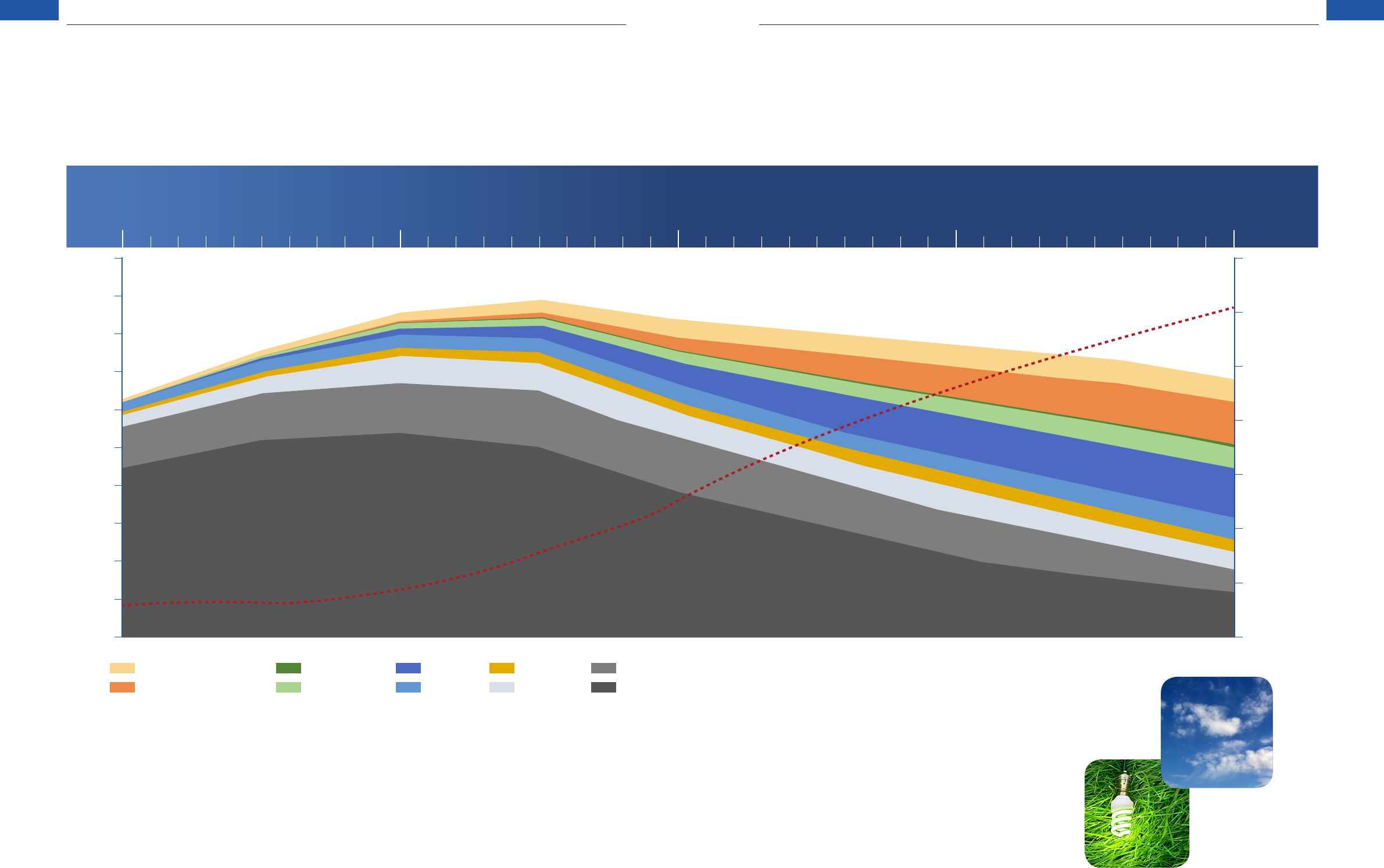
38
39
China 2050 High Renewable Energy Penetration Scenario
and Roadmap Study
China 2050 High Renewable Energy Penetration Scenario
and Roadmap Study
70%
60%
50%
40%
30%
20%
10%
0
50
45
40
35
30
25
20
25
15
10
5
0
2010 2020 2030 2040 2050
Primary energy consumption (100 million tce, caloric value calculation )
Solar and geothermal heating
Solar power
Biomass liquid fuel
Biomass power
Wind power
Hydropower
Nuclear power
Natural gas
Petroleum
Coal

国网电力科学研究院
STATE GRID ELECTRIC POWER RESEARCH INSTITUTE
国网能源研究院
STATE GRID ELERGY RESEARCH INSTITUTE
N
O
R
T
H
C
H
I
N
A
E
L
E
C
T
R
I
C
P
O
W
E
R
U
N
I
E
R
S
I
T
Y
PARTNERS
TECHNICAL SUPPORT
ENERGY RESEARCH INSTITUTE
NATIONAL DEVELOPMENT AND REFORM COMMISSION
